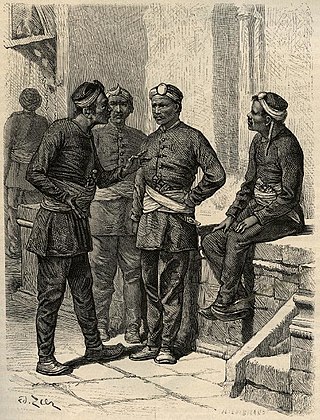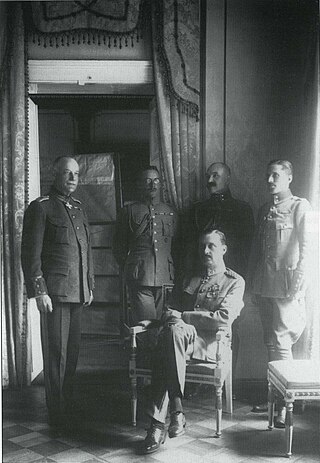
A non-commissioned officer (NCO) is a military officer who does not hold a commission. Non-commissioned officers usually earn their position of authority by promotion through the enlisted ranks. In contrast, commissioned officers usually enter directly from a military academy, officer training corps (OTC) or reserve officer training corps (ROTC), or officer candidate school (OCS) or officer training school (OTS), after receiving a post-secondary degree.

The Gurkhas or Gorkhas, with the endonym Gorkhali, are soldiers native to the Indian subcontinent, chiefly residing within Nepal and some parts of North India.
Sergeant major is a senior non-commissioned rank or appointment in many militaries around the world. Sergeants Major serve as the senior enlisted advisor to the commander.
A chief petty officer (CPO) is a senior non-commissioned officer in many navies and coast guards, usually above petty officer.

Adjutant is a military appointment given to an officer who assists the commanding officer with unit administration, mostly the management of “human resources” in an army unit. The term adjudant is used in French-speaking armed forces as a non-commissioned officer rank similar to a master sergeant or warrant officer but is not equivalent to the role or appointment of an adjutant.
The chart below shows the current enlisted rank insignia of the United States Army, with seniority, and pay grade, increasing from right to left. The enlisted ranks of corporal (E-4) and higher are considered non-commissioned officers (NCOs). The rank of specialist is also in pay grade E-4, but does not hold non-commissioned officer status; it is common that a soldier may never hold the rank of corporal, and instead be promoted from specialist to sergeant, attaining junior NCO status at that time.

The mess is a designated area where military personnel socialize, eat and live. The term is also used to indicate the groups of military personnel who belong to separate messes, such as the officers' mess, the chief petty officer mess, and the enlisted mess. In some civilian societies this military usage has been extended to the eating arrangements of other disciplined services such as fire fighting and police forces.
Havildar or havaldar is a rank in the Indian and Pakistani armies, equivalent to sergeant. It is not used in cavalry units, where the equivalent is daffadar.

Quartermaster is a military term, the meaning of which depends on the country and service. In land armies, a quartermaster is an officer who supervises logistics and requisitions, manages stores or barracks, and distributes supplies and provisions. In many navies, a quartermaster is a seaman or petty officer with responsibility for navigation and operation of the helm of a ship.
Risaldar, meaning the commander of a risala or risalah in Persian, is a mid-level rank in cavalry and armoured units of the Indian and Pakistan Army. In other arms, such as the infantry, the equivalent rank is subedar.
Subedar is a military rank in the militaries of South Asia roughly equivalent to that of a warrant officer. Historically classed in the British Indian Army as a Viceroy's commissioned officer, the rank was retained in the Indian Army and Pakistan Army after independence. The rank of subedar is classed as a junior commissioned officer rank in India and Pakistan.
Junior commissioned officer (JCO) is a group of military ranks which is higher than havildar and lower than lieutenant. The term is only used by Nepal, Bangladesh, India, and Pakistan. Senior havildars are promoted to JCO rank on the basis of merit and seniority, restricted by the number of vacancies. JCOs are treated as a separate class and hold additional privileges. Primarily the term was associated with armies but since the 2000s India's and Pakistan's navies and air forces are using the term to indicate their chief petty officers and warrant officers.
A viceroy's commissioned officer (VCO) was a senior Indian member of the British Indian Army. VCOs were senior in rank to warrant officers in the British Army, and held a commission issued by the viceroy. Also known as "Indian officers" or "native officers", they had authority only over Indian troops and were subordinate to all British King's commissioned officers, Indian Commissioned Officers (ICO) and King's commissioned Indian officers (KCIO).
The Indian Army, the land component of the Indian Armed Forces, follows a certain hierarchy of rank designations and insignia derived from the erstwhile British Indian Army (BIA).

The Madras Regiment is the oldest infantry regiment of the Indian Army, originating in the 1750s as a unit of the British East India Company. The regiment took part in numerous campaigns with the British Indian Army and the post-independence Indian Army. The Madras Regiment primarily recruits from the erstwhile Madras state and the kingdom of Mysore. However, the 9th and 16th battalions were later formed from troops from the kingdoms of Travancore and Cochin in present day Kerala.
Risaldar-major was originally a cavalry officer rank of the British Indian Army. During the British Raj, it was the highest rank natives could achieve.
First sergeant is typically a senior non-commissioned officer rank, used in many countries.
Sub-inspector (SI), or sub-inspector of police or police sub-inspector (PSI), is a rank used extensively in South Asia: in the police forces of Bangladesh, Pakistan, India, and Sri Lanka, which are primarily based on the British model. It was formerly used in most British colonial police forces and in certain British police forces as well. The rank usually was in charge of a police substation or assisted an inspector.
Subedar Sukhdev Singh, SM was a Junior Commissioned Officer (JCO) in the Indian Army. He served in the 16 Grenadiers battalion. On 5th October 2021, he was killed in action during a cross-border firing at Nowshera Sector in Rajouri district, Jammu and Kashmir. He was posthumously awarded the Sena Medal. During his service, he also took part in the 1999 Kargil War.








